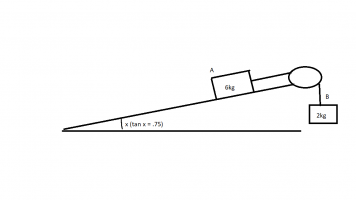James10492
Junior Member
- Joined
- May 17, 2020
- Messages
- 50
Dear math-helpers,
I have come across the following problem which yet again has presented me with difficulty. Observe the diagram that I made in MS paint:

"Box A of masss 6kg rests on a rought plance which is inclined at an angle x to the horizontal, where tan x = .75. The coefficient of friction between the box and the plane is m. Box A is attached to one end of a light inextensible string, which passes over a smooth pulley. The string is attached to a second box B, of mass 2kg, which hangs freely below the pulley.
The system is released from rest: given that A begin to slide down the incline, what is the range of possible values of m?"
I would begin by trying to formulate equations of motion for each particle as is the normal procedure in these pulley-problems:
T−2g=2a6gsinx−F−T=6a6gsinx−m[6gcosx]−T=6a
You want to show that the downward sliding force of A is greater than the combined resistive forces of the friction and the tension in the rope, and for what range of m this would be true.
I don't see how you are supposed to proceed from here, as both a and T are unknown quantities. I don't see how you can solve using a simultaneous equation. Adding the equations of motion leads to an expression for a that involves the undefined 'm'.
This was only a 3 mark question so I think I am probably missing a trick here.
I have come across the following problem which yet again has presented me with difficulty. Observe the diagram that I made in MS paint:

"Box A of masss 6kg rests on a rought plance which is inclined at an angle x to the horizontal, where tan x = .75. The coefficient of friction between the box and the plane is m. Box A is attached to one end of a light inextensible string, which passes over a smooth pulley. The string is attached to a second box B, of mass 2kg, which hangs freely below the pulley.
The system is released from rest: given that A begin to slide down the incline, what is the range of possible values of m?"
I would begin by trying to formulate equations of motion for each particle as is the normal procedure in these pulley-problems:
T−2g=2a6gsinx−F−T=6a6gsinx−m[6gcosx]−T=6a
You want to show that the downward sliding force of A is greater than the combined resistive forces of the friction and the tension in the rope, and for what range of m this would be true.
I don't see how you are supposed to proceed from here, as both a and T are unknown quantities. I don't see how you can solve using a simultaneous equation. Adding the equations of motion leads to an expression for a that involves the undefined 'm'.
This was only a 3 mark question so I think I am probably missing a trick here.
